If you own a piano more than say 30 yrs. old (and that would likely be a great majority of you) then here’s a great question for you to consider…
Has your Piano Action ever been Reconditioned?
First you ask…”A Piano Action? What is that? My piano has one of those?” And your next question is likely “What is reconditioning ?” And “why do I need to have my piano action reconditioned?” After all, the nice salesman when I bought the piano guaranteed that my piano would last forever and I would never have to do anything else to it, other than tune it. Well, not to be too hard on the salesperson, but given how pianos are designed and the materials that are used, that sort of statement just cannot be true. As long as pianos are made with materials that wear, they will need routine maintenance to repair, replace, adjust, clean, and lube them.
So, the answer to the first questions is “YES”. Most (if not all) pianos have an “action”, which contains most of the working parts of the piano (the guts) that need to be removed from time to time for routine service and adjustments. The answer to the second question, “What is reconditioning ?” And “why do I need to have my piano action reconditioned?”, lies in the below explanations…..
First, there are basically two major types of piano actions. Upright actions and Grand actions.
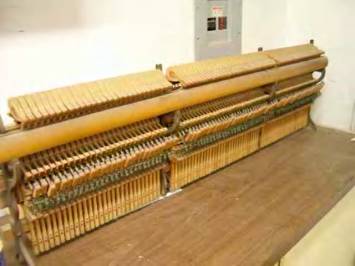
Upright Piano Action
Upright Actions:
Upright actions (spinets, consoles, studios, old uprights) consist basically of the the hammers, the whippen assemblies, and the dampers. Each is mounted to a series of rails that hold them in proper alignment to the strings and keys so that when a key is depressed to play a note, energy is properly transferred from the key to its corresponding string(s). Upright actions are by nature quite a bit simpler in design than the grand actions. This is primarily due to the fact that the upright action does not have a specialized repetition lever like the grand does.
Most upright actions are pretty easy to remove from the piano for repairs. The exception to this would be most spinets and player pianos. They are some of the most difficult actions to work on.
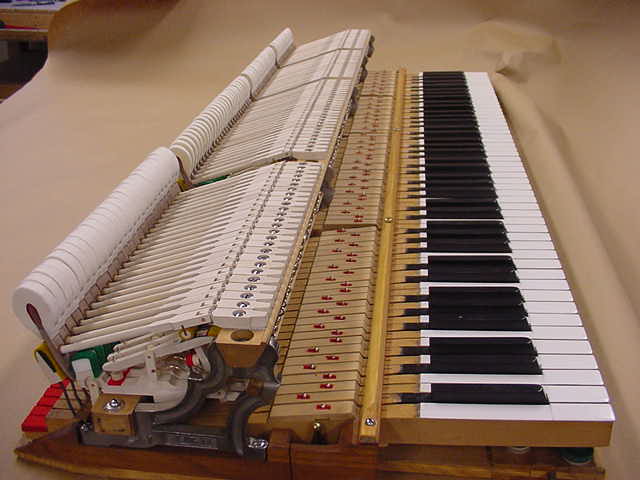
Grand Piano Action
Grand Piano Actions:
Grand Piano Actions are similar in basic function, but in many ways quite different. The grand action parts are also mounted on a series of rails that can be removed from the piano for service and adjustments. Noticebly different, however, is that the hammers are in a different orientation than on the upright action. The grand action also contains the keys which the upright doesn’t. In addition to the keys, the grand action also holds the hammers, and whippen assemblies. The whippen assemblies of most modern grands have a repetition lever which allows a note (the “jack” for those know their piano parts) to fully reset before the key has risen totally back to rest. This allows for better “repetition” of the note than in uprights. An upright key has to fully rise back to rest position for the note (“jack”) to reset in order for the next note to be played.
Moving on…..
This is not a lesson on how actions work, however, I did want you to know that there are basic differences between each type action and that all actions can be….and NEED to be removed from time to time for routine cleaning and maintenance.
Reconditioning:
Reconditioning is a term which refers to a combination of procedures that is done on a piano action to bring it back to good operating condition again. Actions that I recondition will always be thoroughly cleaned, screws tightened, moving parts lubricated, worn or broken parts repaired or replaced, and hammers shaped.
Most pianos I service are well past needing reconditioned, to be quite honest. Years of playing have compacted the leather and felt parts whose purpose are to create cushions between certain parts and keep others in proper alignment and adjustment. The felt hammers that strike the strings also get compacted and deeply grooved over time and tone is eventually adversely affected, not to mention the damage that is occurring to the hammer itself. A piano that is never maintained will eventually begin to deteriorate and fall into disrepair. As one part fails, it puts added wear and stress on other parts, and the damaging effects begin to multiply throughout the piano.
Below are some of the main things that are usually addressed when an action comes to the shop for reconditioning:
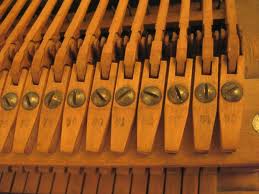
Hammer Flange Screws
Tighten all Action Screws: There are close to 300 screws in an average piano action (not including the ones used for adjustments). That’s 300 screws that just hold hammers and whippens tightly to the rails in proper alignment, screws that hold the damper heads at the proper height and alignment to the strings, screws that hold the action frame together, and so on. As humidity in the air changes, the moisture content of the wood rails and wood hammer/whippen flanges will change in size and shape slightly and cause screws to become loose in time. If your piano is making clickety – clackety noises while you play, there’s a good chance you have loose flange screws throughout the action. Other things can cause these sounds too, but loose screws are an easy place to start. Loose screws lead to all sorts of trouble, including, loose, wobbling hammers…which in turn will grind the face of the hammers flat…which ruins the hammers. Tightening screws is an important, but highly overlooked maintenance item that is very easy and doesn’t take all that long to do.
One short example: I played a piano a couple weeks ago that had a very noisy action, and by simply tightening all the screws, the piano played so much differently…quiet and solid feeling like it’s supposed to be. Amazing.
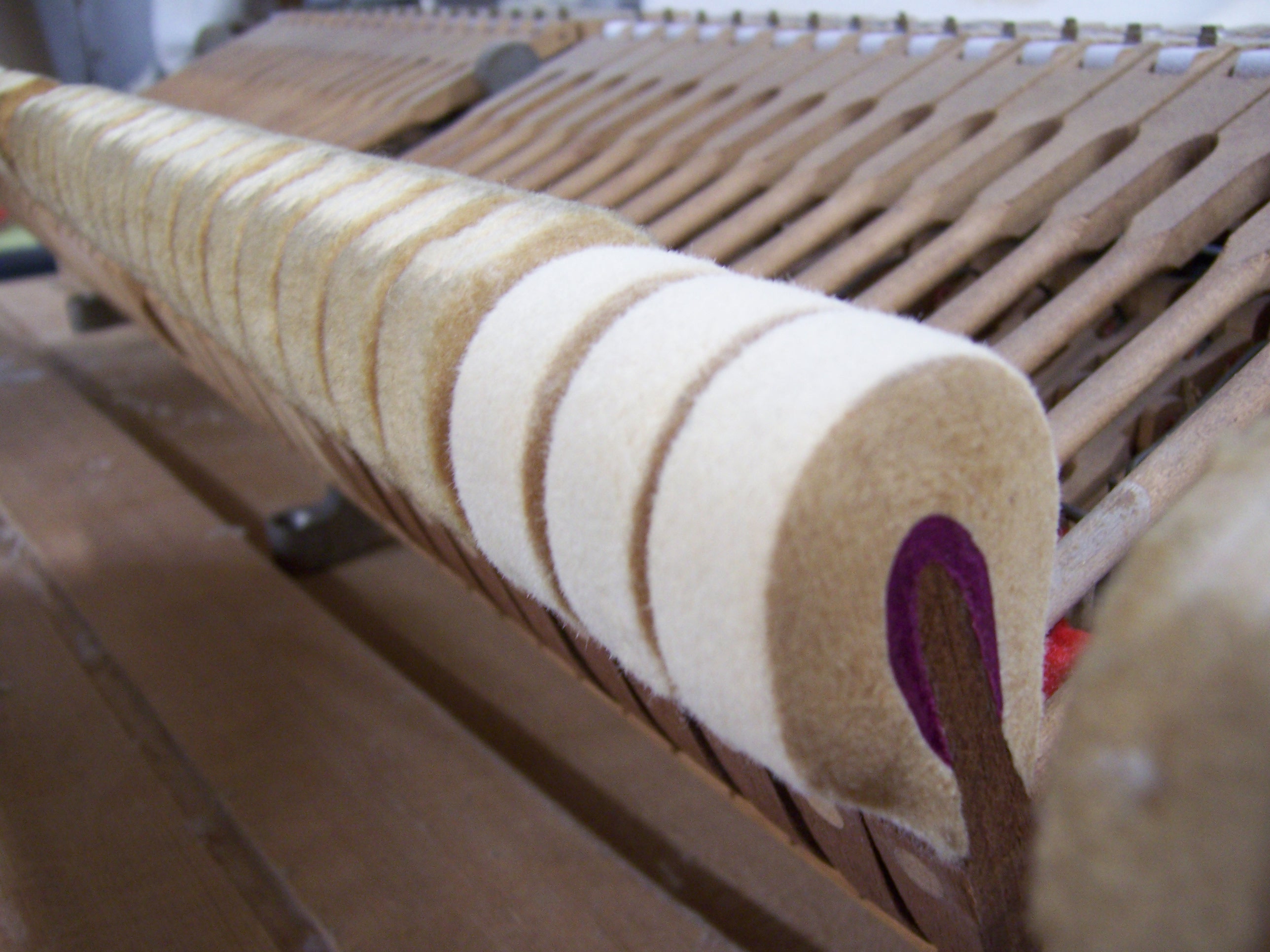
Hammer Shaping
Hammer Shaping: Shaping the hammers can help restore the piano’s tone. After the screws are all tightened, now is the time to shape those hammers to bring back their nice round shape that helps them rebound off the strings as they were intended to do. Flat hammers hit the strings with more of a “thud” and transfer an excessive amount of energy to the string. This can cause broken strings and/or broken hammer shanks. Hammers will always have some grooves, but those that have deep grooves really should be shaped if they can. After being heavily shaped several times, hammers can become too small to function correctly and the set will need to be replaced, but don’t let that concern you. Most pianos have never had their hammers shaped, so they can sure stand it. Once done, if the piano is not a concert piano being used heavily all the time, the shaping will last for many more years to come.
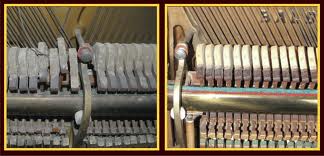 Cleaning and Lubricating Action Parts: Piano actions, like everything else, will collect years of dust. That dust works itself down into all the small moving parts of a piano and can gunk it up quite well, causing sluggish notes, squeaks, a very heavy feel to the keys, notes that don’t repeat, and things like that. Actions can be removed from the piano, moved outdoors, and carefully blown out with compressed air to remove most dust and foreign objects from the action. Some parts can be brushed lightly to remove other dirt that remains, and the action can be lubricated as needed to free up any tight moving parts (note: only special lubricants made for pianos should be used and unless you know what you are doing, any removing of the action and cleaning should be done by a trained piano technician to prevent costly damage to your action).
Cleaning and Lubricating Action Parts: Piano actions, like everything else, will collect years of dust. That dust works itself down into all the small moving parts of a piano and can gunk it up quite well, causing sluggish notes, squeaks, a very heavy feel to the keys, notes that don’t repeat, and things like that. Actions can be removed from the piano, moved outdoors, and carefully blown out with compressed air to remove most dust and foreign objects from the action. Some parts can be brushed lightly to remove other dirt that remains, and the action can be lubricated as needed to free up any tight moving parts (note: only special lubricants made for pianos should be used and unless you know what you are doing, any removing of the action and cleaning should be done by a trained piano technician to prevent costly damage to your action).
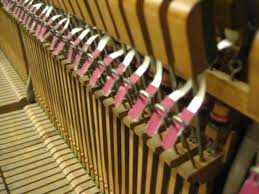
Bridle Straps
Bridle Straps: A very common repair is to replace the bridle straps on an upright action. These straps are necessary to be in good condition and adjusted properly so that the action can be removed and replaced in the piano properly for servicing. Without going into too much explanation, suffice it to say that without the bridle straps in place to hold certain piano parts in place (whippens), the action is very difficult to put back into the piano without damaging parts. During reconditioning, these are almost always replaced if worn or missing.
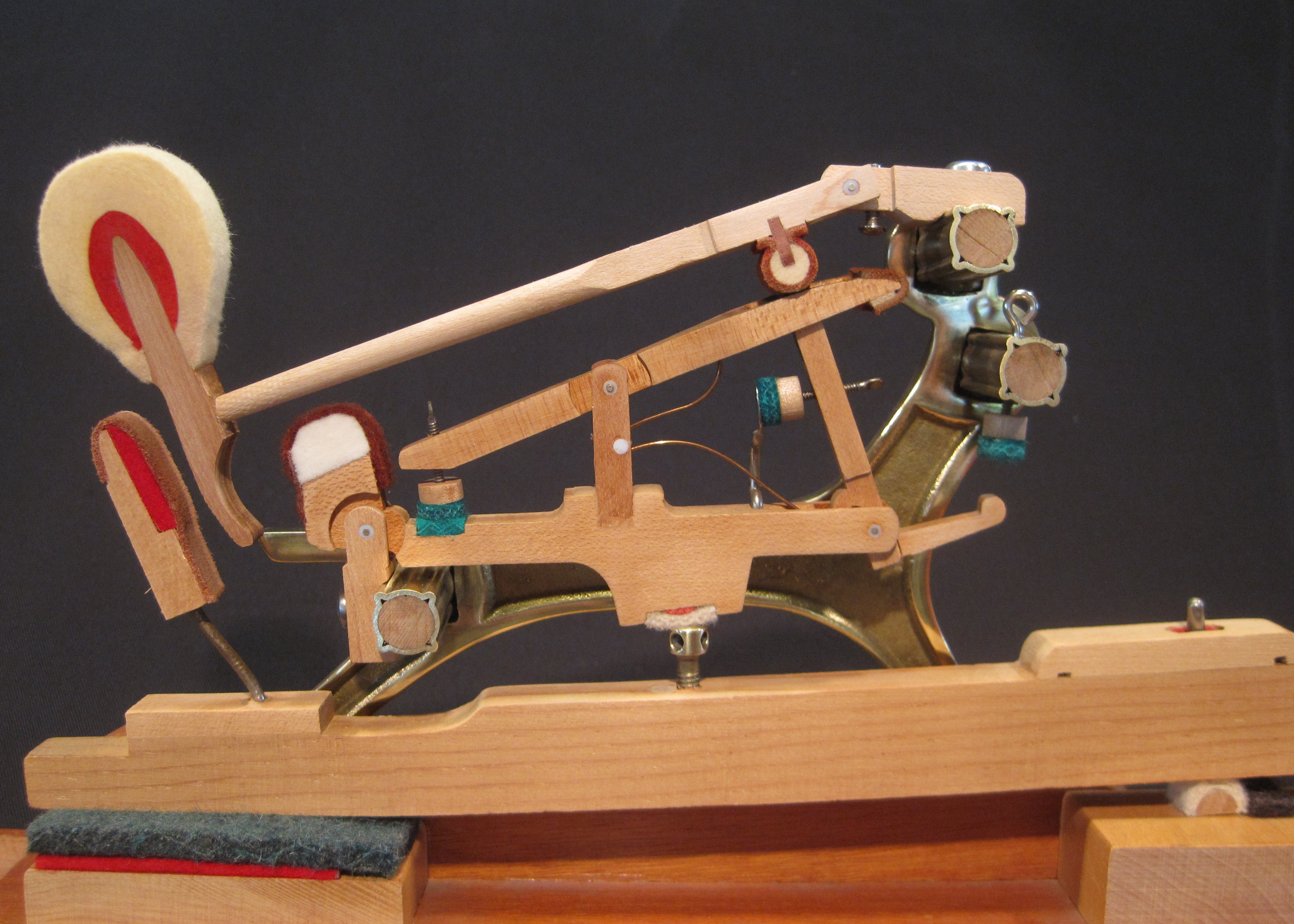
Much Felt/Leather in an Action
Worn Felts/Leathers: There 88 keys on most pianos, therefore on those pianos consider that there are also 88 hammer assemblies, 88 whippen assemblies, and either 88 keys(grands) or 88 dampers (uprights) on the removable action. So, for every note on the piano, (see grand piano note in picture which shows a key, whippen assembly, and hammer assembly) there are approximately 15-25 small pieces of felt or leather that are used to cushion, control friction, stop hammer travel, quiet action noises, dampen strings, etc. That’s between 1320 and 2200 pieces of felt/leather just in an average piano action. They do wear with age, harden, get dry and brittle, fall off because of failing glue, not to mention those that become nesting materials for mice or insect larvae, as well as damage caused by moths. So, there is a very good chance, especially on older pianos, that some felts/leathers may need replaced in order to help your piano action function properly as it should.
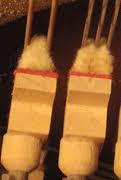
Old Dampers
Dampers: Damper felts will harden, compress, and deform over time and can cause poor string dampening. Sometimes you will hear a “zoink” sound, or a slight buzz sound just as the dampers contact the string as you slowly let up on the key after playing a note. While not necessarily a standard thing to replace while doing an action reconditioning, if yours needs it, while the action is in the shop is a great time to have them replaced.
If your piano action has never been reconditioned, it would be wise to ask your piano technician to evaluate whether or not your piano is in need of being reconditioned. If done correctly, you will be amazed at the difference that a clean, well functioning action will make to your playing.
Until next time…”Make a Joyful Noise!”